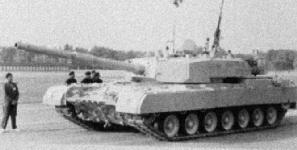




One of the early Arjun prototypes was unveiled in April 1985, with a number of prototypes undergoing technical testing while desert trials were scheduled for that summer. At the time, it was reported to have a 120mm smooth-bore main gun and would use a 1400-hp MTU-based diesel until an indigenous one was ready. Weight would be about 50 tons, and the tank would cost about $1.6 million (U.S.). Development costs rose about 500 percent throughout the �80s, and through a development process plagued with delays, the end product visually resembles the German Leopard II, however, unlike the German vehicle, its future remains in doubt.
As of mid-2000 India planned to acquire T-90 tanks, based on field trials which had already been completed. Although orders had been placed for the supply of 124 Arjun tanks through the Defence Research Development Organisation, it would be difficult to predict when these orders would be fufilled. Until such time, T-90 tanks would serve to counter Pakistan's T-85 tanks.Pakistan�s announcment in 1995 of a deal with Ukraine to purchase T-84s caused a flurry of activity in the Indian tank development community. And on 9 January 1996, the Arjun was formally unveiled and cleared for mass production. Considered comparable to the M1A2 Abrams, Leopard 2, and Leclerc, the 59-ton "15th Variant" can achieve a maximum speed of 70 kph (55 mph) and cross-country speed of 40 kph with its 1400-hp powerplant. The 1,610-liter fuel tank allows for a cruising range of 200 km (120 miles). To ensure crew survivability, production versions will have the indigenously-researched and developed �Kanchan� composite armor, an automatic fire detection and suppression system, and an NBC protection system designed and built by the Bhabha Atomic Research Center.
The rifled 120mm gun, which includes a muzzle reference system, is made of ESR steel and is fitted with a thermal sleeve and fume extractor. All main gun rounds use a semi-combustible cartridge case with increased energy propellant for higher muzzle velocity and greater penetration characteristics. In addition to the usual suite of rounds, an anti-helicopter round is under development as well. The Arjun�s fire control system includes a laser rangefinder, ballistic computer, thermal imaging night sight, stabilized panoramic sight for the tank commander, and a secondary telescopic sight. The LRF (integral to the gunner�s sight) has a range of nearly 10 km and a thermal imager (which can �see�� at around 5.5 km, recognize a target at 3.1 km and identify targets at 2.5 km). The Arjun fire control system�s ability to fire on the move during the night is a major step forward for Indian armored forces.
The Chassis and Automative System of MBT Arjun comprises main chassis, power pack (1400 HP engine coupled to hydromech transmission), running gear with hydropneumatic suspension, integrated fuel system, advanced electrical system and other dedicated special systems like integrated fire detection and suppression system. The chassis is fabricated from rolled homogenous armour plate using advanced welding technique. Frontal armour is of Kanchan composite sandwitched between armour plates. This fully integrated Arjun chassis and Automative System having smooth riding characteristics can be used as a mobile platform for any advanced weapon system. An extremely effective hydropneumatic suspension system has been developed for MBT Arjun. The suspension is externally mounted and provides vehicle springing and damping. It consists of one bogey wheel pair for each suspension station. Gaseous medium in the hydropneumatic suspension is for all terrain maneuverability for exploiting the power available. Casing and hub of the hydropneumatic suspension are sealed for preventing dust ingression and water seepage into the casing during operation in marshy area or shallow/medium fording. The MBT Arjun is fitted with double-pin steel track with detachable rubber pads. It is made out of steel casting having two bores for insertion of rubberised pins. It is an integral piece incorporating guide horns and has got a provision for insertion of detachable pads. The end connectors are induction-hardened in the area which comes in contact with the sprocket teeth to prevent wear.
The integrated fire and explosion suppression system developed for MBT Arjun is based on state-of-the-art technology. The indigenous development of this system is considered to be a breakthrough in the field of fire protection engineering. It is capable of suppressing hydrocarbon fuel fire/explosion resulting from an enemy hit on the tank or due to any malfunctioning of the engine, transmission or any electrical short circuiting. The system is based on infra-red detectors for the detection of fire/explosion in the crew compartment of the battle tank and a continuous type of linear thermal detector popularly known as fire-wire for the engine compartment. Halon-1301 has been employed as a fire extinguishing medium. The system is capable of detection and suppression of hydrocarbon fuel fire/explosion in the crew compartment within 200 milliseconds and in the engine compartment within 15 s thereby enhancing the chances of survivability of the crew and battle effectiveness of the tank.
Further improvements were deemed necessary even after the Arjun design profile was accepted again in July 1996. On 27 August 1996, the Defense Production and Supplies Secretary ordered 15 pre-production tanks from the Heavy Vehicles Factory, Avadi (at which point, estimates placed the project cost at $112 million). As of mid-1997 the list of faults after 20 years of development was not encouraging. In addition to numerous technical modifications to its fire and gun control systems, the fire control system in particular has been found unable to perform in temperatures above 42 degrees Celsius (108� F). The DRDO has been considering scrapping the current Arjun fire control system in favor of whatever is accepted for the T-72M1 upgrade program. Defects noticed during the user trials of the Arjun Mk.1 MBT, including over-heating of the engine in Rajasthan desert areas, had supposedly been �by and large overcome� while other complaints were being addressed.The first 120 tanks to be built would cost $4.2 million each, while other cost estimates places the figure at $5.6 million each per tank by 2001, given a purchase of 124 tanks to equip two regiments. Production of the first batch of tanks might take more than the planned five years, given the capacity at the Avadi factory.
Planned Arjun variants include mobile assault guns, an observation post vehicle, an air defense (gun or missile) version, a recovery vehicle, an engineer vehicle, and bridgelayers. New bridgelayers and recovery vehicles were necessary, given the Arjun�s substantial weight increase over the T-72M1 series.Specifications | ||||||||||||||||||||||||||||||||||||||||||||||||||||||||
|
ARJUN Mk 1 (15th Preproduction Model) Weight |
59 tons (58.5 tonnes) |
Length (gun forwards) |
10.19m |
Width (over tracks) |
3.5m |
(w/ skirts) |
3.85m |
Height (w/o 12.7mm AAMG) |
2.32m |
Engine |
1400 HP MTU 838 Ka 501Diesel |
Transmission |
Semi-automatic with 4 forward and 2 reverse gears.(also reported as ZF
automatic) |
Fuel |
1610 ltrs |
PERFORMANCE |
| Max Speed |
72-70 kph (55 mph) |
Cross Country |
Speed 40 kph |
Cruising Range |
200 km (120 miles) |
Ground Pressure . |
84 kg/cm Square |
Ground Clearance |
.45m |
Slide Slope: |
60% |
Climbing Gradient |
35� |
Trench |
2.43 m (also given as 3m) |
Vertical Obstacle |
.9m |
Ford |
1.4 m |
ARMAMENT |
| Main Gun |
120mm, stabalized w/ MRS (APFSDS, HE, HEAT, HESH and smoke) |
| 12.7mm AA Gun (probably NVST) |
| 7.62mm Coax (probably PK-T) |
| 2 X 9 Smoke Grenade Launchers |
LRF Range |
10 km |
Sights |
Thermal (Max Rng 5.5 km) |
Active and Passive |
Defensive Systems 'Arena' a possibilty, probable Laser Warning
System |
| ||
